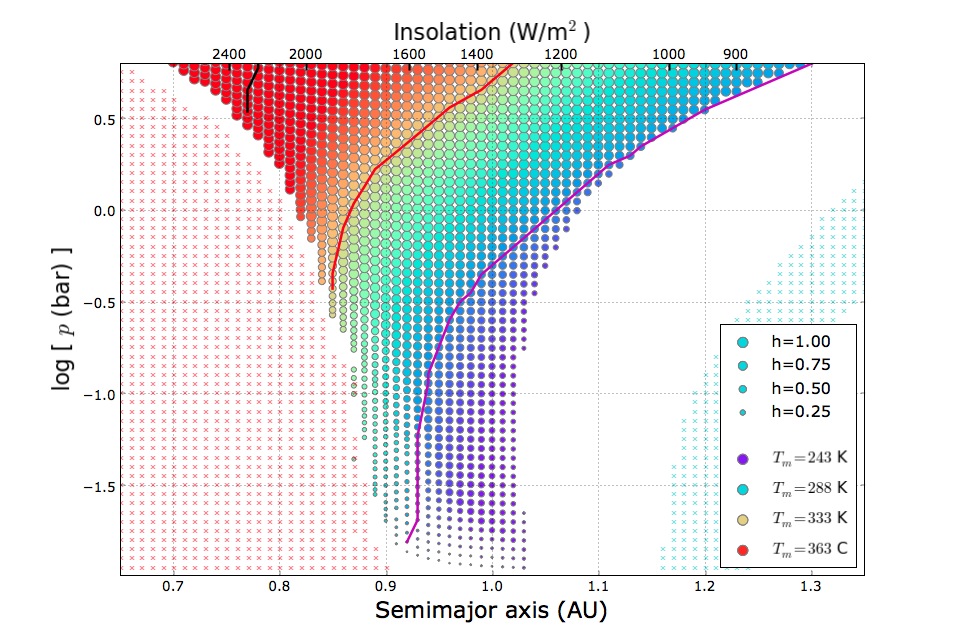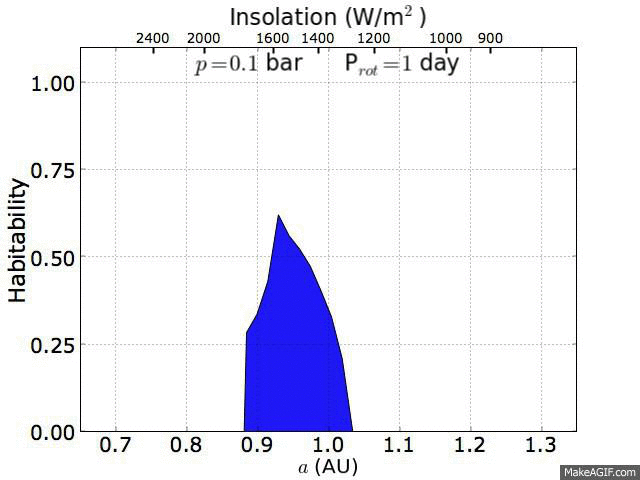INAF - OATs
Astrobiology and Habitability
Planetary Habitability
The habitable zone of Earth-like planets with different levels of atmospheric pressureIn this paper (Vladilo et al. 2013, ApJ, 767, 65) we present a new Energy Balance Model (EBM) of planetary climate and we apply our EBM to investigate the surface habitability of planets with an Earth-like atmospheric composition but different levels of atmospheric pressure. By running a large number of simulations we build up a 2-D habitable zone, where we plot the habitability, h, as a function of the orbital semi-major axis, a, and planet surface pressure, p. The habitability, defined as the mean orbital fraction of the planet's surface on which liquid water could exist, is estimated from the pressure-dependent liquid water temperature range, taking into account seasonal and latitudinal variations of surface temperature. The pressure-dependent habitable zone is shown in the left figure below. The circles indicate solutions of the climate simulations with mean global annual habitability h>0. The area of the circles is proportional to the habitability h; the colors are coded according to the mean annual global surface temperature, Tm. The size and color scales are shown in the legend. The solid lines are contours of equal mean temperature Tm=0 C (magenta), 60 C (red) and 120 C (black). More details can be found in the paper. 

In the right animation above we show the effects of pressure on the habitable zone. All model parameters are set equal to the Earth value, except for the stellar insolation and the surface pressure. As pressure increases, the fractional habitability increases and the habitable zone becomes wider. More animations showing the seasonal evolution of the surface temperature are provided here. This is the Earth at p=0.2 bar: one can see that, due to the low surface pressure, the mean global annual temperature is low (Tm=-12 C) and the seasonal excursions of the zonal temperatures are quite intense. This is the Earth at p=5 bar: in this case, due to the high pressure, the mean global annual temperature is high (Tm=+52 C) and the seasonal excursions of the zonal temperatures are quite moderate. A more exotic case is shown here, we you can see an Earth-like planet with axis obliquity at 90 degrees and p=0.3 bar: in this case an equatorial belt of ices is formed as a consequence of the high inclination of the planet rotation axis. Here we provide several figures where we compare some predictions of our EBM model with calculations presented in previous work. Concerning the influence of eccentricity on planetary habitability, here are our versions of Fig. 2 by Williams & Pollard (2002) and of Fig. 7 (case e=0.6, left panel) by Dressing et al. (2010). Concerning the influence of axis obliquity on planetary habitability, here is our version of Fig. 1B by Williams & Kasting (1997). The comparison with Fig. 8 by Spiegel et al. (2009) is shown here, where we present the case of obliquity at 60 degrees (left panel and right panel) and the case at 90 degrees (left panel and right panel). For this last value of obliquity, our EBM does not produce a snow-ball transition, at variance with the model by Spiegel et al. (2009). References: Dressing et al. 2010, ApJ, 721, 1295 - Spiegel et al. 2009, ApJ, 691, 596 - Williams & Kasting 1997, Icarus, 129, 254 - Williams & Pollard 2002, Int. J. of Astrobiology, 1, 61 |